On this page
The Australian Early Development Census (AEDC) is a nationwide data collection that looks at how young children are developing at the time they start their first year of full-time school. The data helps communities gain insight into what is working well and what needs to be improved or developed so children can thrive.
Community organisations, non-government organisations (NGOs), local governments, businesses and community members can use the data to see how they can best support children in their community.
About the AEDC
The AEDC measures children’s development in 5 areas (or domains) and can help predict how children will do in health, education and social life as they grow up.
Learn more about the AEDC, what the collection measures and how to access and understand the data:
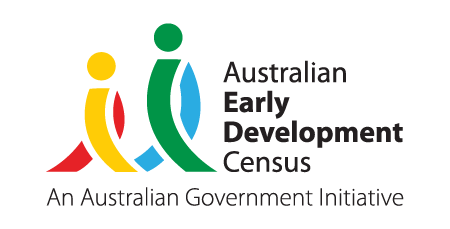
What the SA results show
Current AEDC results for South Australian children show that:
- over 50% of children are developmentally on track on all 5 domains as they start school
- 1 in 4 children are developmentally vulnerable – these children are found across all socio-economic areas and communities in our state.
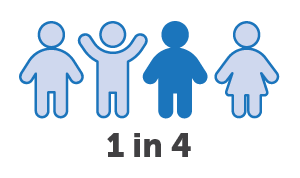
Why early development is so important
The environments and experiences children are exposed to from pregnancy through to school age shape their development.
Starting behind can have lifelong health, wellbeing, academic, social and economic impacts.
We want all children to have access to the building blocks of healthy development, including:
- nourishing food
- economic and housing security
- access to education and learning
- opportunities for play
- safe, green environments
- supportive communities.
If we can recognise and address developmental needs of children early, we can help get them back on track. This may prevent the need for more costly and intensive help in the future.
Your role in supporting local children and families
Community organisations, NGOs, local government, businesses and community play a vital role in providing important care and public health support for children and families where they live and when they’re needed.
Investing time, effort and resources in children’s early years – when their brains are rapidly developing – brings lifelong benefits to them and to the whole community.
Find more details in the:
- Public Health Indicator Framework (PDF 281KB)
- core care conditions for children and families: implications for policy and practice.
Early childhood education and care services and schools also have a key role.
Learn about how community organisations can partner with the South Australian Office for Early Childhood Development to improve developmental outcomes for our children.
How the data can help you
AEDC results provide a common language to help:
- explore the lived experience of children and families
- share data and other information
- consider who else to connect with
- plan, monitor and evaluate actions in response to early childhood development needs.
When community organisations collectively explore their results, it can help:
- plan for and choose effective interventions
- provide better support for local children and their families
- improve children’s likelihood of developing on track and help build thriving communities.
Access the data
AEDC data provides important population-level evidence. Your community can use the data to:
- understand the factors affecting children’s health, development and wellbeing in your local area
- make decisions about resources, services and programs to meet the needs of children and families
- identify other partners to work with.
Community profiles present results for a suburb or geographic area, usually aligned to local government areas. They include:
- demographics and characteristics of children in the area – providing context for the results
- data for each domain – the proportion of children who are developmentally on track, at risk or vulnerable
- the proportion of children developmentally on track on all 5 AEDC domains, developmentally vulnerable on 1 or more and 2 or more domains.
The domains are:
For more information read:
- about the AEDC domains fact sheet
- about the summary indicators fact sheet
- accessing community results
- understanding AEDC community boundaries.
Learn how to understand the results and data
Read the understanding the results fact sheet or watch the video below.
Video: understanding the data (5:47)
Video transcript – understanding the data
What you can use the data for
Use the AEDC data as an evidence base to:
- inform policy and planning
- review services
- allocate resources and assets
- inform grant processes
- inform collaborative approaches and community engagement
- inform evaluations
- measure progress over time.
The reporting, publication or analysis of AEDC data and results must be in accordance with the AEDC data guidelines.
Tips for local governments
Local governments can use AEDC results when implementing the Reading and Literacy Framework for SA public libraries and SA Outcomes Framework for Children and Young People, planning for preventive health, planning for regional public health and more.
The regional public health planning: using AEDC data guide (PDF 484 KB) provides valuable insights and practical steps for local governments to incorporate AEDC data into their planning processes, ensuring that community needs are met and resources are allocated effectively.
Guidance for policy makers
We have more guidance for you on using AEDC data to support policy and planning for early childhood development. Read our page:
Using the data to inform your planning
Read the AEDC user guide for community service organisations. It can help you think about how you can bring people together in your community and develop coordinated local responses.
Video: using the data to inform your planning (5:42)
Video transcript – using the data to inform your planning
For additional information about using the data read the:
Examples of how communities are using the data
Explore examples of communities using AEDC results including:
- Uniting SA’s Community Strategic Plan 2022-2026
- Campbelltown council child friendly city approach
- Southern and Hills local government area Regional public health and wellbeing plan 2022 – 2027 (PDF 4 MB)
- local government early childhood community initiatives
- AEDC community stories.
Video: Mid Murray family connections (4:58)
This video shows how a network of over 60 stakeholders collectively responds to their community AEDC results.
Video transcript – Mid Murray family connections story

Got a story to share?
If you have an AEDC story to share, we'd love to hear from you.
AEDC resources for community organisations
AEDC resources can help communities take action to provide the environments, relationships, experiences, services and opportunities that can support children to thrive.
Working with families
You can use the following resources in your work with families to support children’s development in the 5 AEDC domains.
Development guides
Print and display or share the development guide posters:

Physical health and wellbeing poster
This fact sheet provides examples of behaviours through which adults can support children’s development of physical health and wellbeing.
Supporting early childhood development guide: physical health and wellbeing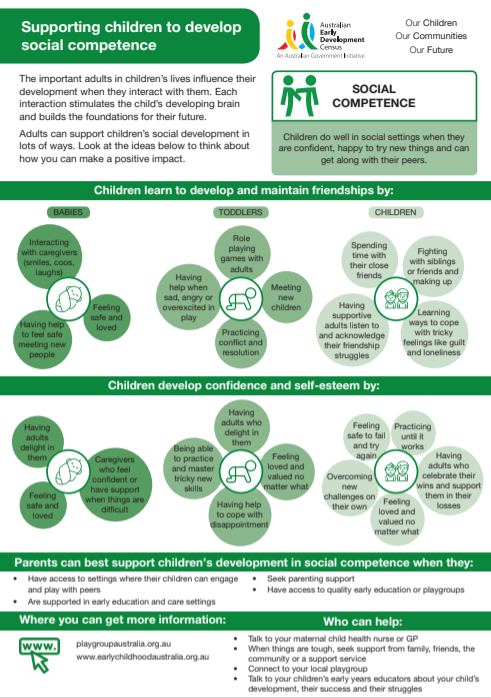
Social competence poster
This fact sheet provides examples of behaviours through which adults can support children’s development of social competence.
Supporting early childhood development guide: social competence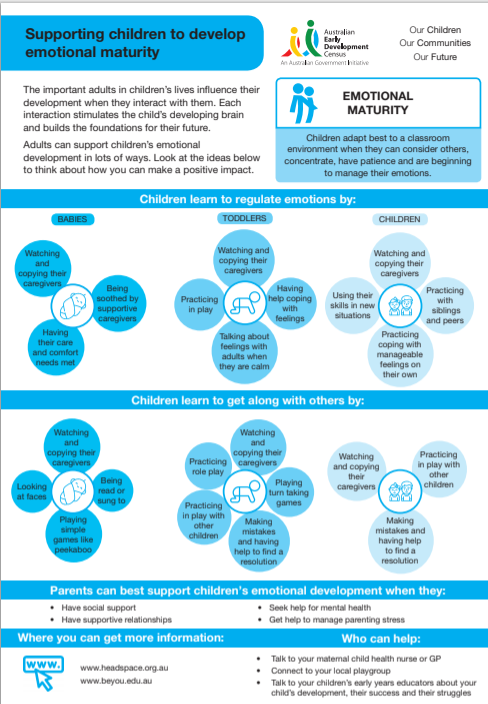
Emotional maturity poster
This fact sheet provides examples of behaviours through which adults can support children’s development of emotional maturity.
Supporting early childhood development guide: emotional maturity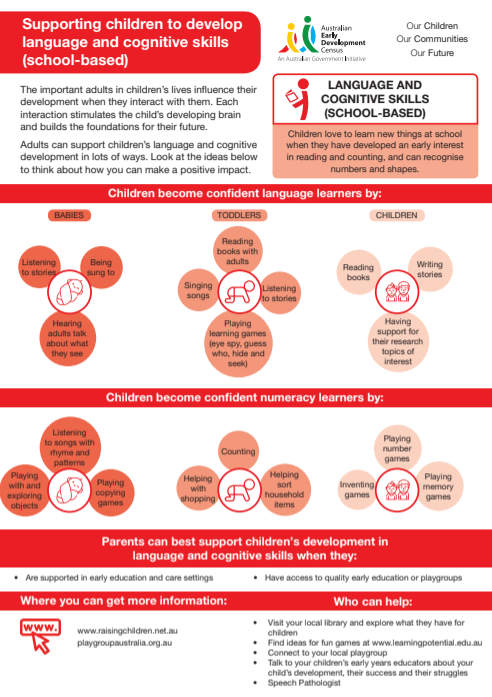
Supporting early childhood development guide: language and cognitive skills (school-based)
This fact sheet provides examples of behaviours through which adults can support children’s development of language and cognitive skills (school-based).
Supporting early childhood development guide: language and cognitive skills (school-based)
Communication skills and general knowledge poster
This fact sheet provides examples of behaviours through which adults can support children’s development of communication skills and general knowledge.
Supporting early childhood development guide: communication skills and general knowledgeMore resources for families
There are many services and resources that you can use in your work to help families and support children’s development and learning. For example:
- Starting Blocks
- Playgroup SA
- Raising Children Network
- Parenting SA
- ASK Adults Supporting Kids
- Families Growing Together
Guidance for families
We also have a page on how families can help support their own child's development and how they can use AEDC results in their community:
Service listings, programs and workshops
- ASK (Adults Supporting Kids) – connects parents and caregivers to information, free local support services and other contacts to support children and young people
- Families Growing Together – Department for Human Services program workshops to parents and caregivers to about parenting
- Preventive Health SA – resources, tools and information to support South Australian families to stay healthy, active and connected
- Raising Children Network – parenting videos, articles and apps backed by Australian experts
- Royal Children’s Hospital Melbourne Centre for Community Child Health resource hub – evidence-based publications and resources to support your work with children and families
- SNAICC (National Voice for Aboriginal and Torres Strait Islander children) – works to improve outcomes and opportunities for Aboriginal and Torres Strait Islander children and strengthen the capacities of families across Australia
Data
- Australian Bureau of Statistics – for demographic data to understand community context
- Australian Child and Youth Wellbeing Atlas – visualises health and wellbeing metrics for children and young people
- .idcommunity – demographic, economic, and social profiles by council area
- Wellbeing SA Open Data Portal – access to a wide range of data regarding the health and wellbeing of the South Australian community
- Social health atlases – PHIDU, Torrens University Australia
Funding
Community engagement
- Local Government Association community engagement handbook (PDF 8.4MB)
How the department’s AEDC team can help
The AEDC team can help you:
- understand your community results
- consider demographic factors that may be making a difference
- use the AEDC data.
Contact us via the details below.


